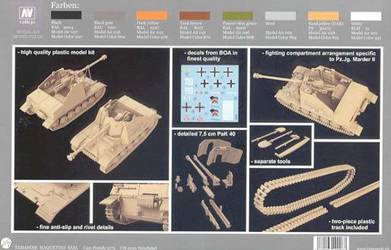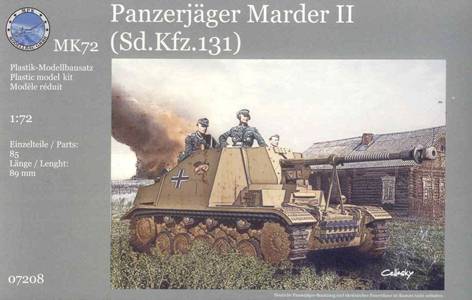The year 2011 has
to be one of my lucky ones for model releases. We have had releases
of not one, but two kits of this Panzerjäger, one of my
favorite vehicles. What spurred this, I am convinced, is my scratchbuilt
conversion of one of these tank destroyers using the ESCI PzKpfw II
kit. If you want a long desired kit to be released, go through the
trouble to scratchbuild one so you don’t need the kit after
all!
This in-the-box kit review covers Mk72’s’s
interpretation in 1/72 scale of a German self-propelled Pak 40 7.5-cm
anti-tank gun mounted on a Panzer II chassis. The vehicle was introduced
in mid-1942 and produced till mid-1943. It can be modeled in service
in Italy, the Northern European front and the Russian Front till the
end of the war. I refer you to the references listed below for further
information.
The term Marder II commonly used for this vehicle will be used in
this review but be aware that according to Thomas Jentz, this was
not the common name during WW2. [Terminology and vehicle information
in this commentary is largely based on the book Panzer Tracts No.7-2
- Panzerjaeger (7.62 cm F.K.(r) auf gp.Sfl. to Marder 38T), by Thomas
Jentz and Hilary Doyle, which I consider the most accurate resource.]
The Box Art, What Do We Have Here?
Mk72 is a relatively new company, as far as I know, and this box art
is typical for their other small scale model kits I have seen. The
box portrays about the most famous Marder II Panzerjäger as far
as modeling and photographs go. On the side of the superstructure
is the Fritz cartoon face. The vehicle is finished in just Dunkelgelb
color; on the gun barrel are many kill rings of a successful crew,
probably the reason why it was so well photographed.
At the front is the long 7.5-cm Pak 40 gun barrel with double-baffle
muzzle brake and same shield as the towed Pak 40 antitank gun. The
suspension, wheels and tracks are the same as the PzKpfw II tank.
There is no false visor to the left of the driver’s visor indicating
this is a factory built Marder II and not a conversion of the tank.
Three crew members are portrayed but no figures are included in the
kit.
The Parts
There are 83 pinkish-yellow color injection molded, styrene plastic
parts on two sprues (though the parts diagram shows three sprues).
Molding quality and detail look very good, no flash and few significant
sink holes.

The above sprue contains the kit upper hull and superstructure parts.
At upper left is the floor (part 10) with a nice (though oversize)
tread pattern. To its right is a very fine, delicate two part travel
support for the gun barrel (parts 43 & 44). The Mk72 upper hull
(part 14) compares well with the same part from the ACE
kit at far right. Comparing the ACE kit with the Mk72 Marder II
we see that they are totally different kits and interpretations of
the Marder II. The Mk72 parts are molded very thin; this is definitely
not a limited-run plastic kit.

Though this looks like one sprue it is actually two sprues according
to the assembly instructions; not important but just to help clarify
things.
At far left are the 12 parts for the
7.5-cm Pak 40 gun. The parts are very delicate. Things I particularly
like is the two part gun shield (parts 55 & 56), the delicate
elevation and traverse handwheels (parts 54), and the barrel molded
separate from the carriage so it can be modeled in recoil if we so
wish. There is even a nice gun sight (part 53) that many Pak 40 kits
leave out. My only concern is that with the gun barrel molded in two
halves as it might sometimes happen that the barrel is oval when glued
together.
At upper center are four lengths of
styrene track lengths (parts 9). The tracks are unique in being only
lengths rather than links & lengths. The track lengths are meant
to be carefully bent over and around the sprocket and idler wheels.
At bottom center are the wheels. The sprocket teeth seem a bit small.
At the right side are many small delicate parts. Cut the handtools
from the sprue very carefully, parts like this tend to break under
the pressure of clippers.

The above scan is a close-up of the Mk72 tracks at far right with
the old, dreadful ESCI polyethylene tracks, ACE’s vinyl and
ACE’s etched brass Marder II kit track. Mk72’s styrene
tracks look good but honestly look too open, lacking detail.

MK72 gives us the standard exploded view type instructions with part
numbers matching the parts diagram. In Step 1 we see assembly of the
lower hull and the molded-on leaf spring suspension. The ammunition
bins on the engine deck are molded closed.
At the bottom is part of a separate
sheet with color multi-view drawings of the four choices of markings
and paint schemes for three Marders on the Ostfront and one in Tunisia.

On the back of the box is a color depiction of the model kit with
a breakdown of its parts and folding the track runs. In the center
are the kit decals for four vehicles. At the top is a color and paint
guide. This is some nice, modeler friendly information to include.
Modeling Research
- Panzer Tracts 7-2 - Panzerjaeger
(7.62 cm F.K.(r) auf gp.Sfl. to Marder 38T), by Thomas Jentz and
Hilary Doyle (2005), Panzer Tracts, P.O.Box 312, Boyds, MD 20841-0334.
- Panzerjager, by Horst Scheiber,
(1998), Schiffer Publishing Ltd.
- ENCYCLOPEDIA OF GERMAN TANKS OF
WORLD WAR TWO, Peter Chamberlain and Hillary Doyle, (1978), Arms
& Armour, and Sterling Publishing.
- http://www.achtungpanzer.com/marder-marten-series.htm
|
